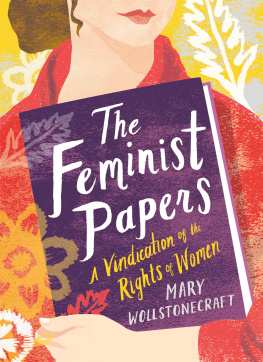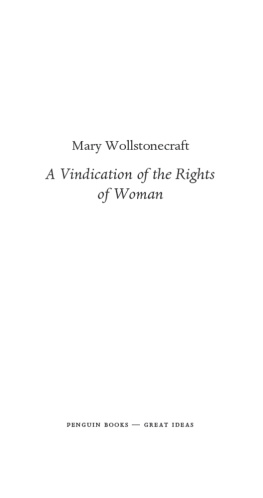W ELCOME TO THE 3 Books To Know series, our idea is to help readers learn about fascinating topics through three essential and relevant books.
These carefully selected works can be fiction, non-fiction, historical documents or even biographies.
We will always select for you three great works to instigate your mind, this time the topic is: Early Feminism.
- A Vindication of the Rights of Woman by Mary Wollstonecraft
- A Room of Ones Own by Virginia Woolf
- Woman in the Nineteenth Century by Margaret Fuller
A Vindication of the Rights of Woman : with Strictures on Political and Moral Subjects (1792), written by the 18th-century British proto-feminist Mary Wollstonecraft, is one of the earliest works of feminist philosophy. In it, Wollstonecraft responds to those educational and political theorists of the 18th century who did not believe women should receive a rational education. She argues that women ought to have an education commensurate with their position in society, claiming that women are essential to the nation because they educate its children and because they could be "companions" to their husbands, rather than mere wives. Instead of viewing women as ornaments to society or property to be traded in marriage, Wollstonecraft maintains that they are human beings deserving of the same fundamental rights as men.
A Room of One's Own is an extended essay by Virginia Woolf, first published in September 1929. The work is based on two lectures Woolf delivered in October 1928 at Newnham College and Girton College, women's constituent colleges at the University of Cambridge. An important feminist text, the essay is noted in its argument for both a literal and figurative space for women writers within a literary tradition dominated by men.
Woman in the Nineteenth Century is a book by American journalist, editor, and women's rights advocate Margaret Fuller. Originally published in July 1843 in The Dial magazine as "The Great Lawsuit. Man versus Men. Woman versus Women", it was later expanded and republished in book form in 1845.The basis for Fuller's essay is the idea that man will rightfully inherit the earth when he becomes an elevated being, understanding of divine love. There have been periods in time when the world was more awake to this love, but people are sleeping now; however, everyone has the power to become enlightened. Man cannot now find perfection because he is still burdened with selfish desires, but Fuller is optimistic and says that we are on the verge of a new awakening.
This is one of many books in the series 3 Books To Know. If you liked this book, look for the other titles in the series, we are sure you will like some of the topics.
M ARY WOLLSTONECRAFT (27 April 1759 10 September 1797) was an English writer, philosopher, and advocate of women's rights. Until the late 20th century, Wollstonecraft's life, which encompassed several unconventional personal relationships, received more attention than her writing. Today Wollstonecraft is regarded as one of the founding feminist philosophers, and feminists often cite both her life and work as important influences.
During her brief career, she wrote novels, treatises, a travel narrative, a history of the French Revolution, a conduct book, and a children's book. Wollstonecraft is best known for A Vindication of the Rights of Woman (1792), in which she argues that women are not naturally inferior to men, but appear to be only because they lack education. She suggests that both men and women should be treated as rational beings and imagines a social order founded on reason.
After Wollstonecraft's death, her widower published a Memoir (1798) of her life, revealing her unorthodox lifestyle, which inadvertently destroyed her reputation for almost a century. However, with the emergence of the feminist movement at the turn of the twentieth century, Wollstonecraft's advocacy of women's equality and critiques of conventional femininity became increasingly important.
After two ill-fated affairs, with Henry Fuseli and Gilbert Imlay (by whom she had a daughter, Fanny Imlay), Wollstonecraft married the philosopher William Godwin, one of the forefathers of the anarchist movement. Wollstonecraft died at the age of 38 leaving behind several unfinished manuscripts. She died eleven days after giving birth to her second daughter, Mary Shelley, who would became an accomplished writer and author of Frankenstein.
A DELINE VIRGINIA WOOLF (25 January 1882 28 March 1941) was an English writer, considered one of the most important modernist 20th-century authors and also a pioneer in the use of stream of consciousness as a narrative device.
Woolf was born into an affluent household in South Kensington, London, the seventh child in a blended family of eight. Her mother, Julia Prinsep Jackson, celebrated as a Pre-Raphaelite artist's model, had three children from her first marriage, while Woolf's father, Leslie Stephen, a notable man of letters, had one previous daughter. The Stephens produced another four children, including the modernist painter Vanessa Bell. While the boys in the family received college educations, the girls were home-schooled in English classics and Victorian literature. An important influence in Virginia Woolf's early life was the summer home the family used in St Ives, Cornwall, where she first saw the Godrevy Lighthouse, which was to become central in her novel To the Lighthouse (1927).
Woolf's childhood came to an abrupt end in 1895 with the death of her mother and her first mental breakdown, followed two years later by the death of her stepsister and a mother figure to her, Stella Duckworth. From 1897 to 1901, she attended the Ladies' Department of King's College London, where she studied classics and history and came into contact with early reformers of women's higher education and the women's rights movement. Other important influences were her Cambridge-educated brothers and unfettered access to her father's vast library.
Encouraged by her father, Woolf began writing professionally in 1900. Her father's death in 1905 caused another mental breakdown for Woolf. Following his death, the Stephen family moved from Kensington to the more bohemian Bloomsbury, where they adopted a free-spirited lifestyle. It was in Bloomsbury where, in conjunction with the brothers' intellectual friends, they formed the artistic and literary Bloomsbury Group.
Following her 1912 marriage to Leonard Woolf, the couple founded the Hogarth Press in 1917, which published much of her work. The couple rented a home in Sussex and moved there permanently in 1940. Throughout her life, Woolf was troubled by her mental illness. She was institutionalized several times and attempted suicide at least twice. Her illness is considered to have been bipolar disorder, for which there was no effective intervention during her lifetime. At age 59, Woolf committed suicide in 1941 by putting rocks in her coat pockets and drowning herself in the River Ouse.

















